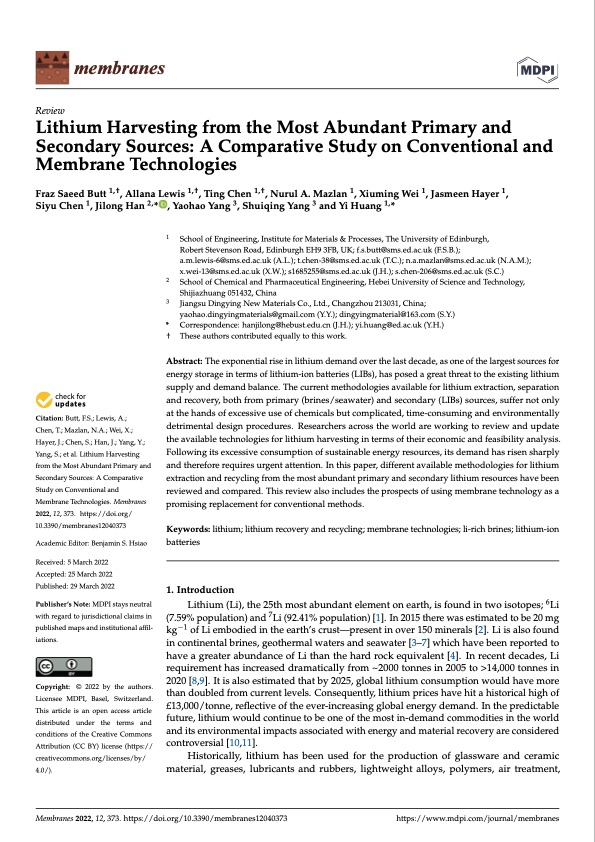
PDF Publication Title:
Text from PDF Page: 001
membranes Review Lithium Harvesting from the Most Abundant Primary and Secondary Sources: A Comparative Study on Conventional and Membrane Technologies Fraz Saeed Butt 1,†, Allana Lewis 1,†, Ting Chen 1,†, Nurul A. Mazlan 1, Xiuming Wei 1, Jasmeen Hayer 1, Siyu Chen 1, Jilong Han 2,* , Yaohao Yang 3, Shuiqing Yang 3 and Yi Huang 1,* Citation: Butt, F.S.; Lewis, A.; Chen, T.; Mazlan, N.A.; Wei, X.; Hayer, J.; Chen, S.; Han, J.; Yang, Y.; Yang, S.; et al. Lithium Harvesting from the Most Abundant Primary and Secondary Sources: A Comparative Study on Conventional and Membrane Technologies. Membranes 2022,12,373. https://doi.org/ 10.3390/membranes12040373 Academic Editor: Benjamin S. Hsiao Received: 5 March 2022 Accepted: 25 March 2022 Published: 29 March 2022 Publisher’s Note: MDPI stays neutral with regard to jurisdictional claims in published maps and institutional affil- iations. Copyright: © 2022 by the authors. Licensee MDPI, Basel, Switzerland. This article is an open access article distributed under the terms and conditions of the Creative Commons Attribution (CC BY) license (https:// creativecommons.org/licenses/by/ 4.0/). 1 2 3 * Correspondence: hanjilong@hebust.edu.cn (J.H.); yi.huang@ed.ac.uk (Y.H.) † These authors contributed equally to this work. Abstract: The exponential rise in lithium demand over the last decade, as one of the largest sources for energy storage in terms of lithium-ion batteries (LIBs), has posed a great threat to the existing lithium supply and demand balance. The current methodologies available for lithium extraction, separation and recovery, both from primary (brines/seawater) and secondary (LIBs) sources, suffer not only at the hands of excessive use of chemicals but complicated, time-consuming and environmentally detrimental design procedures. Researchers across the world are working to review and update the available technologies for lithium harvesting in terms of their economic and feasibility analysis. Following its excessive consumption of sustainable energy resources, its demand has risen sharply and therefore requires urgent attention. In this paper, different available methodologies for lithium extraction and recycling from the most abundant primary and secondary lithium resources have been reviewed and compared. This review also includes the prospects of using membrane technology as a promising replacement for conventional methods. Keywords: lithium; lithium recovery and recycling; membrane technologies; li-rich brines; lithium-ion batteries 1. Introduction Lithium (Li), the 25th most abundant element on earth, is found in two isotopes; 6Li (7.59% population) and 7Li (92.41% population) [1]. In 2015 there was estimated to be 20 mg kg−1 of Li embodied in the earth’s crust—present in over 150 minerals [2]. Li is also found in continental brines, geothermal waters and seawater [3–7] which have been reported to have a greater abundance of Li than the hard rock equivalent [4]. In recent decades, Li requirement has increased dramatically from ~2000 tonnes in 2005 to >14,000 tonnes in 2020 [8,9]. It is also estimated that by 2025, global lithium consumption would have more than doubled from current levels. Consequently, lithium prices have hit a historical high of £13,000/tonne, reflective of the ever-increasing global energy demand. In the predictable future, lithium would continue to be one of the most in-demand commodities in the world and its environmental impacts associated with energy and material recovery are considered controversial [10,11]. Historically, lithium has been used for the production of glassware and ceramic material, greases, lubricants and rubbers, lightweight alloys, polymers, air treatment, School of Engineering, Institute for Materials & Processes, The University of Edinburgh, Robert Stevenson Road, Edinburgh EH9 3FB, UK; f.s.butt@sms.ed.ac.uk (F.S.B.); a.m.lewis-6@sms.ed.ac.uk (A.L.); t.chen-38@sms.ed.ac.uk (T.C.); n.a.mazlan@sms.ed.ac.uk (N.A.M.); x.wei-13@sms.ed.ac.uk (X.W.); s1685255@sms.ed.ac.uk (J.H.); s.chen-206@sms.ed.ac.uk (S.C.) School of Chemical and Pharmaceutical Engineering, Hebei University of Science and Technology, Shijiazhuang 051432, China Jiangsu Dingying New Materials Co., Ltd., Changzhou 213031, China; yaohao.dingyingmaterials@gmail.com (Y.Y.); dingyingmaterial@163.com (S.Y.) Membranes 2022, 12, 373. https://doi.org/10.3390/membranes12040373 https://www.mdpi.com/journal/membranesPDF Image | Lithium Harvesting using Membranes

PDF Search Title:
Lithium Harvesting using MembranesOriginal File Name Searched:
membranes-12-00373-v2.pdfDIY PDF Search: Google It | Yahoo | Bing
Product and Development Focus for Infinity Turbine
ORC Waste Heat Turbine and ORC System Build Plans: All turbine plans are $10,000 each. This allows you to build a system and then consider licensing for production after you have completed and tested a unit.Redox Flow Battery Technology: With the advent of the new USA tax credits for producing and selling batteries ($35/kW) we are focussing on a simple flow battery using shipping containers as the modular electrolyte storage units with tax credits up to $140,000 per system. Our main focus is on the salt battery. This battery can be used for both thermal and electrical storage applications. We call it the Cogeneration Battery or Cogen Battery. One project is converting salt (brine) based water conditioners to simultaneously produce power. In addition, there are many opportunities to extract Lithium from brine (salt lakes, groundwater, and producer water).Salt water or brine are huge sources for lithium. Most of the worlds lithium is acquired from a brine source. It's even in seawater in a low concentration. Brine is also a byproduct of huge powerplants, which can now use that as an electrolyte and a huge flow battery (which allows storage at the source).We welcome any business and equipment inquiries, as well as licensing our turbines for manufacturing.| CONTACT TEL: 608-238-6001 Email: greg@infinityturbine.com | RSS | AMP |